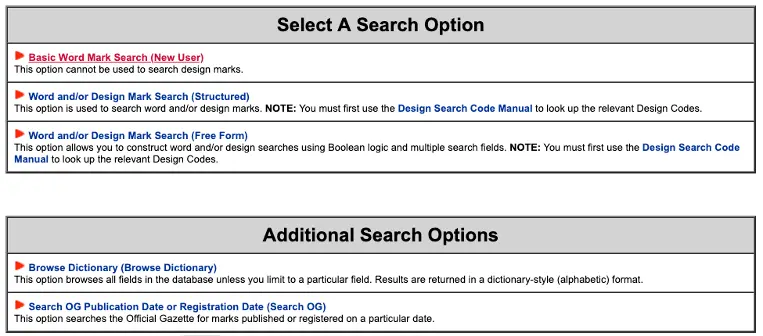Trademarks are an important part of any small business.
For this reason, you should take the time to make sure your mark is both legally strong and easily recognizable to help ensure future success.
While registering your first trademark may seem a bit confusing at first, the process is actually quite simple. In fact, it usually boils down to a few simple steps:
- Make a list of several potential marks that could work for your business.
- Research all the marks on this list using the USPTO's online resources (among other databases).
- Choose your final mark and file a trademark application for it with the USPTO.
In this article we'll largely focus on the second point.
However, the most important thing to remember is that performing a quick trademark search before you submit your application is the easiest way to avoid potential complications down the line.
A thorough trademark search can help you identify any marks that are confusingly similar to your own and can help you strengthen your brand in the long run by helping you document your due diligence at the start of the trademark process.
What is the Trademark Electronic Search System (TESS)?
A screenshot from TESS's home page, taken Aug. 2019.
The Trademark Electronic Search System (TESS) is a free online database of all existing federal trademarks.
It is maintained by the USPTO and regularly updated so as to provide a comprehensive look at all registered and pending federal trademarks in the United States.
However, you should also take care to remember that TESS is not a fully comprehensive end-all-be-all database.
It does not collect information from any of the state trademark departments, and it has no way of tracking common law trademarks or other uses outside of federal registration.
For this reason, while you should always start your trademark search with TESS, you should also check other databases as well to make sure an unregistered trademark doesn't slip under your radar.
A common way to get around this problem is to retain an experienced attorney who can create a trademark search report for your business.
However, such reports are often part of a larger trademark registration case, and there's certainly nothing stopping you from creating one yourself.
Why Should I Use TESS?
One of the cornerstones of trademark law is the idea that no two trademarks should be similar enough to one another that they create consumer confusion.
As an example, the USPTO would never let two businesses with the same name register trademarks in the same industry, as doing so would only confuse consumers as to which one is which (e.g. there cannot be two separate "Krispy Kreme" businesses in the food industry).
However, you can (usually) register a similar trademark to an existing business if your business and the existing business operate in different industries.
This is why, for example, "Delta Airlines" and "Delta Faucets" can exist at the same time as registered marks, since one deals with airline services while the other sells a consumer product for bathrooms and kitchens.
When you register a new trademark with the USPTO, an examining attorney working for the USPTO will perform a trademark search for your mark as a part of the normal application process.
Put another way, when you submit your application, an experienced attorney will research your mark to see if any confusingly similar marks already exist in your industry.
For this reason, you should always do a similar search yourself before you submit your application, since you know for a fact that an attorney will judge your application based on this criteria.
How to Use TESS: The Basics
The USPTO provides numerous resources on their website with additional information on the who, what, when, where, and why of trademark registration.
It's highly recommended that you review these resources before you submit your application.
However, at a basic level the trademark search process can be broken down into three separate phases:
- Develop a search plan that includes all potential mark variations.
- Run all of these variations through TESS to see if you can find any confusingly similar marks.
- Review your results (preferably with an attorney).
We'll outline each below, be we also highly encourage you to read our comprehensive Ebook (linked above) on the subject as well.
1) Develop Your Search Plan
This step is actually rather easy, and you can do it at your own convenience as you brainstorm possible ideas and variations for your new trademark.
Basically, you want to write down a short list of the potential marks and names you like the most, and then create a list of all possible variations of that mark.
So, for example, if I wanted to register the name "Ballerina Photo Frames" as a new trademark, I would also want to write down any possible variations of this mark so that I can make sure there are no conflicting marks in the federal register.
In general, you should write down possibilities for all of the following:
- All forms of the distinctive elements of the mark (i.e. plurals);
- Each distinctive element alone (i.e. word by word);
- Acronyms and what they stand for;
- All the legal word equivalents, or synonyms;
- Component parts of individual terms when necessary;
- Phonetic equivalents (i.e. fishing/phishing); and
- All English equivalents (i.e. theater/theatre).
To return to my "Ballerina Photo Frames" example, I could add several variations to my list:
- "Ballerina Photo Frame" (the singular version)
- "Dancer Photo Frames" (synonym)
- "Ballerina Foto Frames" (a phonetic equivalent)
Importantly, you should run all of these versions (both the original and any variations) through TESS when you perform your final trademark search.
For this reason, having a list of all possible search strings is key to a thorough trademark search.
2) Run Your Ideas Through TESS
When you first enter the Trademark Electronic Search System, the program will offer you three different levels of search:
- Basic;
- Structured; and
- Free form.
These range in complexity both in search results and in knowledge of the TESS system itself.
You should always go through these in this order, so that you can narrow down your search as you familiarize yourself with TESS.
For example, the best place to start is usually to perform a Basic trademark search using all of the terms on your list.
If you find any confusingly similar marks to your own through this Basic trademark search, it's highly likely that you'll have to return to the drawing board to draft some new trademark ideas.
However, even if the Basic search returns no results you still need to spend a little more time in the program to double check the results.
Often, this means performing a thorough structured trademark search on each of your search terms to ensure that none of them infringe too closely on an already existing mark.
You can find the instructions to perform such a search on the USPTO's website.
However, this is usually where people feel that they might need the assistance of an attorney, as proving a negative (i.e. proving that your mark does not infringe upon another) can be rather difficult in practice.
3) Review Your Results (With an Attorney)
A common reason that your trademark application could be denied is due to a “likelihood of confusion” between your trademark and an existing one.
While searching TESS and ruling out any federal trademarks from the likelihood of confusion will greatly increase your chances, conducting a thorough search outside of that will help even more.
For this reason, you should also search for your mark (and any relating terms) in databases such as your state's trademark registry. You should also do a quick search using Google or a similar search engine.
Even if your trademark search comes back clean, however, there could still be legal issues that prevent your trademark from passing.
Registration is not always guaranteed, but a private trademark attorney can help you to better understand the process, advise you on the best course of action, deal with legal issues, and perform the trademark clearance search for you.
Conclusion
Basically, the more time you spend searching in TESS and other sources, the stronger the likelihood that your trademark application will pass.
Though the trademark application process can be overwhelming, performing a trademark search on your own doesn’t have to be difficult.
Whether you eventually hire an attorney or not, doing an initial search through TESS can be a great place to start.
In fact, before you design your trademark, searching through TESS can help you get an idea of how to make yours more unique than others out there.
The more your trademark stands out, the more noticeable your business is.


